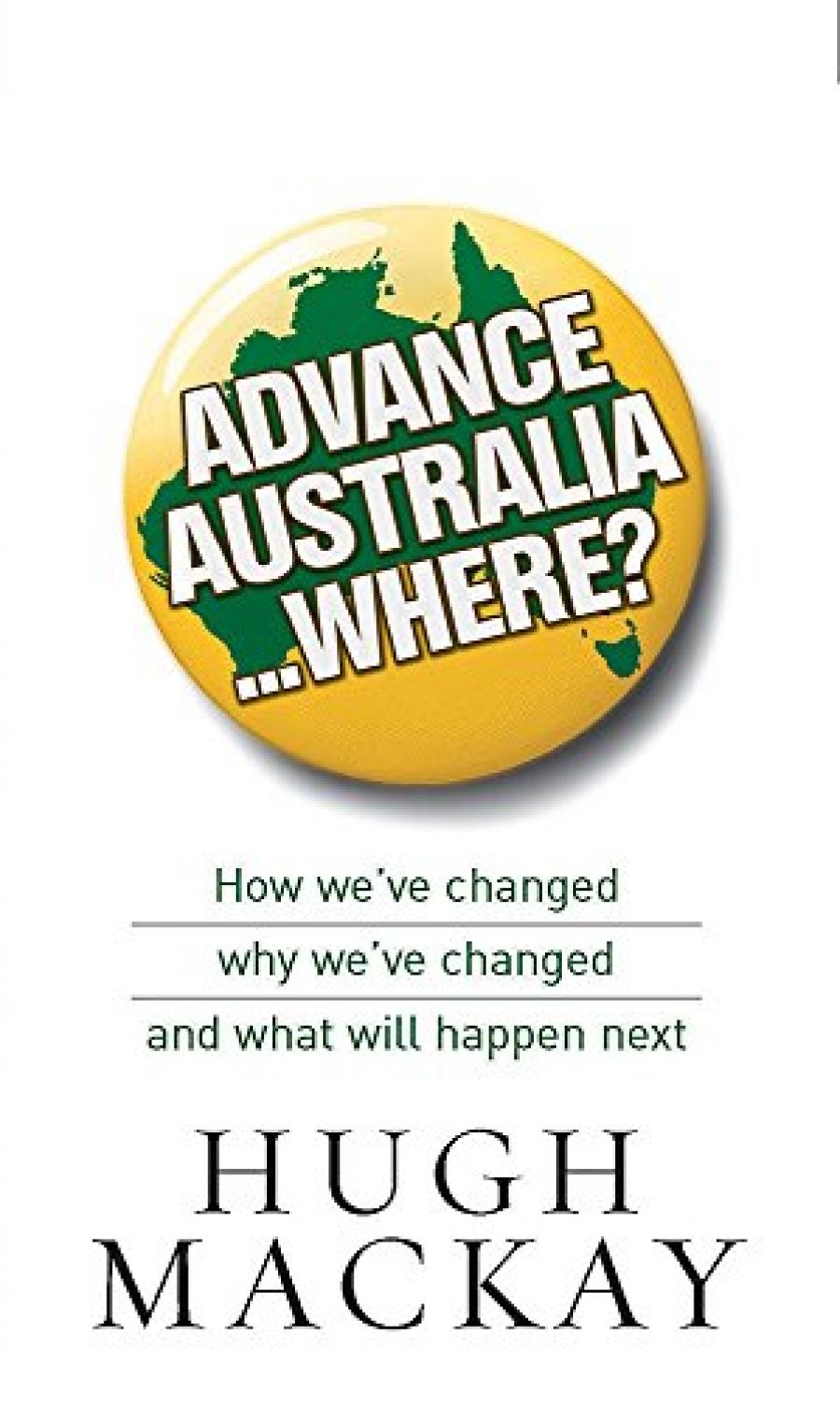
- Free Article: No
- Contents Category: Cultural Studies
- Review Article: Yes
- Article Title: The big picture
- Online Only: No
- Custom Highlight Text:
Advance Australia … Where? is such an eye-catching pun on Australia’s national anthem that it is no wonder that it has been used, with slight variations, as the title of at least eight books and pamphlets since World War II. Such publications have tended to express an individual author’s vision for the nation. In contrast, the latest Advance Australia … Where?, written by Hugh Mackay, mainly discusses current trends in public opinion, although it includes a few cautious predictions about the future and a number of suggestions for social reform.
- Book 1 Title: Advance Australia … Where?
- Book 1 Subtitle: How we’ve changed, why we’ve changed, and what will happen next
- Book 1 Biblio: Hachette Livre, $35 pb, 356 pp
- Book 1 Readings Link: booktopia.kh4ffx.net/AoQnZa
In 1979, social researcher and psychologist Hugh Mackay and his team began a continuous programme of qualitative research – The Mackay Report – which has explored Australian attitudes and reactions to topical issues such as the media, work and personal relationships. Funded by subscriptions from business and government organisations, The Mackay Report provided subscribers with several studies of specific social issues each year. In 2003 the research programme became the Ipsos Mackay Report after it was taken over by Ipsos Australia. Mackay remains a consultant with the project, and has used data from several decades of the Ipsos Mackay Report in Advance Australia to offer a snapshot of modern Australian society.
Mackay’s chief research method involves conducting small group discussions and personal interviews. In the former, the researcher outlines the topic, but does not participate in the conversation: the avoidance of formal questioning prevents the discussion from being inhibited by the values and interests of the researcher. The personal interview is similarly non-directive: the researcher encourages the respondent to express his or her views on the topic without the interviewer setting the agenda by direct, formal questioning.
Such social research is clearly valuable in allowing the voices of Australians to be heard and understood. However, Mackay does not provide the reader with sufficient information about the process of collecting this data. I was left with a number of unanswered questions when I put the book down. For instance, how much of an attempt was made to gain regional perspectives? What was the demographic mix of respondents? As these interviews and group discussions are crucial to Mackay’s analysis, a more detailed explanation of the methodology would have been helpful.
Surprisingly, Mackay does not always provide direct evidence from his extensive data to support his interpretations of social trends. If, for example, in previous decades, men ‘quickly learned how to adopt the camouflage of feminism, but … consoled each other … with the hopeful thought that this might all come horribly unstuck for women’, then it would have been appropriate for readers to see verbatim quotes from the respondents so they could make up their own minds. Moreover, Mackay’s generalisations about the under-thirties (e.g. assertive in the workplace and classroom; unfazed by an increasingly flexible and insecure job market) occasionally seem reliant on observations by the author and his older respondents regarding the young people most likely to be easily noticed by our society: the bouncy extroverts.
Leaving aside these reservations, Mackay has written a highly readable book which covers many community concerns, ranging from the eternally topical (e.g. gender relations, work–life balance, etc.) to issues that have attracted less public debate (e.g. arts funding and multiculturalism). Mackay adds colour and interest to his text by quoting from opinion columns, specialist reports and authors. He also employs statistical data to provide explanations and context for the opinions uncovered in his social research. Mackay makes frequent reference to Australian Bureau of Statistics figures, although the absence of footnotes sometimes makes it difficult to verify details such as the date of the statistics.
Advance Australia paints a fairly depressing picture of a modern Australia, defined on the one hand by excessive individualism, and on the other by a strong yearning for a sense of community. This theme is perhaps best explored in a chapter called ‘Paradox: The IT revolution’, which shows how, while mobile phones and email can be a great tool for human connection and exchanging information, such technology can create greater stress, isolation and loss of social skills.
Mackay also argues that the relentless pace of modern life, combined with the perception that political and social issues were beyond the control of the individual, have led many Australians to become disengaged from public debate, focusing instead on those aspects of life that they can control, such as family and living standards. Nonetheless, the author views renewed public concern with issues such as the environment and industrial relations as possible symptoms of a new interest in ‘Big Picture’ issues.
What is the right balance between fostering individual civic responsibility and depending on public institutions to create an environment that encourages a more thoughtful, caring society? Judging from his eloquent concluding remarks, Mackay has most faith in the power of the individual to change society for the better: ‘Example counts. Every ripple travels.’ But Mackay also advocates the formation of interventionist government policies to tackle global warming, to reduce poverty and to maintain high standards in Australian schools. However, with twenty-one chapters crowded with analysis of individuals and their social context, there is not enough space for the author to fully develop his philosophy of the role of government in the life of the individual and society in general. The subject of Mackay’s next book, perhaps?


Comments powered by CComment